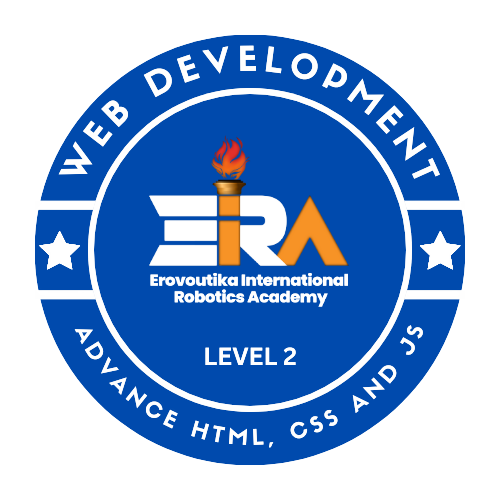Enrollment Web Development
Certifications Level 2
Certifications
Advance HTML, CSS and JS
 LEVEL 2
Advance HTML, CSS and JS
LEVEL 2
Advance HTML, CSS and JS
HTML, or HyperText Markup Language, serves as the foundational language for web development, allowing developers to create the structure and content of web pages by utilizing various tags and elements to define text, images, links, forms, and multimedia. CSS, which stands for Cascading Style Sheets, complements HTML by enabling web designers to control the presentation and layout of those web pages, giving them the ability to customize colors, fonts, margins, padding, and more to achieve visually appealing and consistent designs across different devices and screen sizes. Meanwhile, JavaScript, a versatile scripting language, brings interactivity and dynamism to web pages, allowing developers to add interactive elements, form validation, animations, and even build complex web applications, thereby enhancing the overall user experience and responsiveness of the website. Together, HTML, CSS, and JavaScript form the core trio of web development, enabling the creation of fully functional, aesthetically pleasing, and engaging web experiences.
Exam Coverage
1. HTML
* HTML and its role in web development * HTML document structure: doctype, head, body, and basic elements
* Working with text: headings, paragraphs, lists, and formatting tags
* Adding images and multimedia using HTML tags
* Creating hyperlinks and anchor tags
* Understanding HTML forms and form elements (input, select, textarea, etc.)
* Semantic HTML: using meaningful tags like header, footer, section, article, etc.
* Tables and their structure in HTML
* Creating and styling HTML lists
* Basic HTML5 elements: canvas, video, audio, and more
* Accessibility in HTML: using alt attributes, labels, and ARIA roles
2. CSS
* Introduction to CSS and its role in web development * CSS syntax and rule structure: selectors, properties, and values
* Styling text: fonts, colors, text alignment, and decorations
* Working with CSS box model: margins, padding, borders
* Understanding and using CSS classes and IDs
* Positioning elements: static, relative, absolute, and fixed
* CSS layout techniques: floats, flexbox, and grid
* Creating responsive designs with media queries
* CSS transitions and animations
* CSS transformations: rotate, scale, translate, etc.
* Introduction to CSS preprocessors (e.g., Sass, LESS) - optional
3. JavaScript
* Introduction to JavaScript and its role in web development * JavaScript syntax: variables, data types, and operators
* Working with functions and control structures (if-else, loops)
* DOM manipulation: accessing and modifying HTML elements with JavaScript
* Handling user events: click, input, mouse events, etc.
* Understanding and using JavaScript objects and arrays
* Asynchronous JavaScript: callbacks, promises, and async/await
* Handling form validation with JavaScript
* Working with JSON data and APIs
* Introduction to AJAX and Fetch API
* Debugging JavaScript code
How to evaluate examination ?
1. HTML
Limited understanding of HTML basics, struggles with syntax and structure.
Adequate knowledge of HTML fundamentals, can create simple web pages with basic tags and structure.
Proficient in HTML, demonstrates a good grasp of tags, attributes, and document structure.
Advanced understanding of HTML, capable of building complex web pages, effectively using semantic elements, and optimizing for accessibility.
2. CSS
Limited knowledge of CSS, struggles with applying styles and understanding selectors.
Basic understanding of CSS styling, can modify colors, fonts, and basic layout properties.
Proficient in CSS, demonstrates competence in using selectors, properties, and applying advanced styling techniques.
Advanced CSS skills, able to create complex layouts, responsive designs, and custom animations.
3. JS
The examination will assess the proper use of JavaScript syntax, including variables, data types, and operators;
accurate implementation of functions and control structures (if-else, loops) to perform tasks; correct manipulation
of the Document Object Model (DOM) to access and modify HTML elements; handling and responding to user events
(click, input, mouse events) using JavaScript; effective use of JavaScript objects and arrays to store and manage
data; understanding and implementation of asynchronous JavaScript using callbacks, promises, or async/await;
accurate handling of form validation using JavaScript; retrieving and working with JSON data and APIs using
JavaScript, and appropriate use of AJAX or Fetch API to interact with server-side resources.
| Exam Name | Exam WDV-102 |
|---|---|
| Pre-requisites | WDV-101 |
| Validity | Lifetime |
| Exam Duration | 55 minutes |
| Number of Questions | 40 questions |
| Type of Question | Multiple Choice |
| Passing Score | 70% |
| Cost | $17 USD |
| Languages | English |